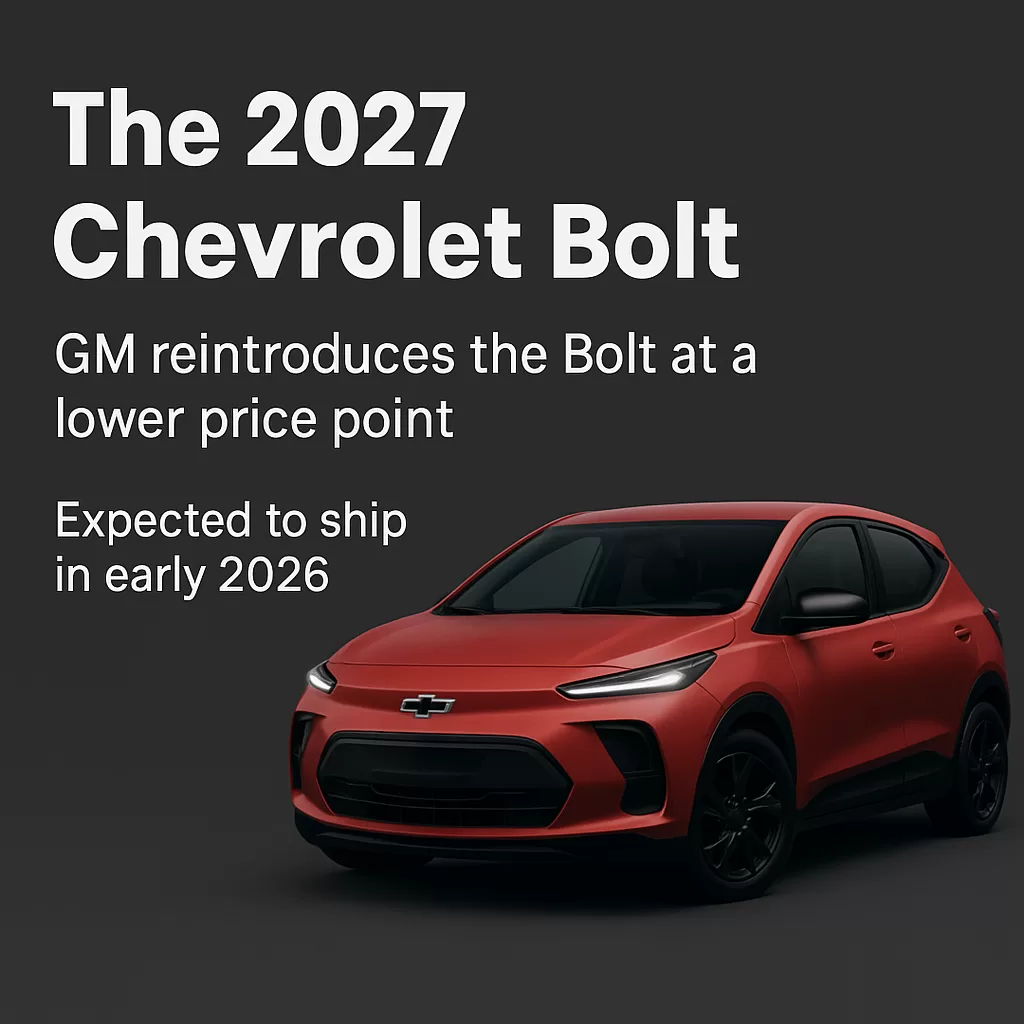GM’s Affordable EV Comeback That Could Transform Leasing in 2026
In a major move to reshape the electric vehicle (EV) market, General Motors (GM) has announced the return of the Chevrolet Bolt, one of America’s most affordable and accessible electric cars. According to The Wall Street Journal, GM plans to relaunch the Bolt as a 2027 model year vehicle with a starting price below $30,000, making it one of the most budget-friendly EVs in the U.S. market. The new model is expected to ship in early 2026, setting the stage for what could be a transformative year for EV leasing and ownership.
For drivers exploring ways to lease a Chevrolet Bolt or other electric vehicles, this development signals an important shift: affordability, accessibility, and innovation are converging to make EVs more attainable than ever.
GM’s Strategic Move: Why Bring Back the Bolt?
After discontinuing the Chevrolet Bolt in 2023, GM’s decision to revive it just a few years later has sparked industry buzz. The automaker’s strategic pivot reflects several key market realities:
Consumer Demand for Affordable EVs: According to Cox Automotive’s 2025 EV Outlook, 46% of consumers said EV prices were the top barrier to adoption. With the average EV costing $55,000+, a sub-$30,000 Bolt fills a critical affordability gap.
Competition from Tesla & Hyundai: Tesla’s Model 3 and Hyundai’s Ioniq 5 dominate the sub-$40k segment. GM’s re-entry at a lower price point positions it to capture first-time EV buyers.
Tax Credit Incentives: Depending on assembly location and battery sourcing, the Bolt may qualify for up to a $7,500 federal EV tax credit, making leases even more attractive.
GM Chair and CEO Mary Barra said in an investor statement, “The Bolt has always stood for accessible innovation. The next generation takes that vision even further — affordable, connected, and sustainable.”
Key Features & What to Expect from the 2027 Chevrolet Bolt
While full technical specs will be released closer to launch, GM has shared several early details that hint at substantial upgrades:
Ultium Battery Platform
The 2027 Bolt will use GM’s Ultium battery technology, the same architecture that underpins models like the Cadillac Lyriq and Chevy Equinox EV. Expect improved range (estimated 300+ miles) and faster charging speeds.
Next-Gen Interior & Tech
GM has confirmed a new infotainment system, expected to include Google built-in, Android Auto, and Apple CarPlay support — a nod to consumer feedback. Advanced driver-assistance features such as Super Cruise could be optional on higher trims.
Simplified Charging & Fleet Compatibility
The vehicle will use the North American Charging Standard (NACS), aligning with the Tesla Supercharger network by 2026. This step expands convenience for both retail and fleet leasing customers.
Design Evolution
Early renders suggest the Bolt will retain its compact hatchback silhouette but incorporate a sleeker, more aerodynamic exterior with modern LED lighting and digital displays.
Affordability & Leasing — Why the 2027 Bolt Could Be a Game-Changer
EV affordability remains a top challenge for most consumers — and that’s where leasing steps in. The Bolt’s expected MSRP below $30,000 could translate to lease offers under $300/month, depending on incentives and residual values.
📉 The Cost Comparison
| Vehicle | Starting MSRP | Est. Lease (36 mo) | Range (mi) | Federal Tax Credit Eligible |
|---|---|---|---|---|
| 2027 Chevrolet Bolt | ~$29,995 | ~$279/mo | 300+ | Yes |
| Tesla Model 3 | ~$38,990 | ~$399/mo | 272–341 | Partial |
| Hyundai Ioniq 5 | ~$41,800 | ~$429/mo | 303 | Partial |
| Nissan Leaf | ~$28,140 | ~$299/mo | 212 | Yes |
Sources: Wall Street Journal, Kelley Blue Book, Cox Automotive, EPA estimates
This affordability gives GM a competitive edge, especially in the leasing sector, where monthly cost drives decision-making.
Market Context: EV Sales, Leasing, and Consumer Behavior
EV Market Growth
According to S&P Global Mobility, EVs represented 9.1% of all U.S. new vehicle registrations in 2024, up from 7.2% in 2023. That figure is expected to exceed 13% by 2026, fueled by lower prices, improved infrastructure, and growing lease incentives.
Leasing Is Making a Comeback
Leasing fell sharply during the pandemic but has rebounded. Cox Automotive reports leasing penetration rose to 21% in early 2025, up from 17% the year prior. EVs are leading this resurgence since tax credits apply more easily to leased vehicles than to purchases.
Consumer Confidence in EVs
A J.D. Power E-Vision Report found that 61% of consumers are now open to leasing an EV if monthly costs fall below $400 — a threshold the Bolt is likely to meet.
The Bolt’s Role in GM’s Broader EV Strategy
GM aims to produce over 1 million EVs annually by 2027, spanning Chevrolet, Cadillac, Buick, and GMC brands. The Chevrolet Bolt will anchor the lower end of this lineup, complementing premium models like the Cadillac Lyriq.
In addition:
GM’s Orion Assembly Plant in Michigan will handle production, with heavy emphasis on domestic battery sourcing to meet federal credit rules.
The Bolt will help GM meet its 2035 goal of phasing out internal combustion engine (ICE) vehicles entirely.
Competitive Outlook — How the Bolt Stacks Up
Against Tesla
Tesla remains dominant in EV mindshare, but its vehicles’ higher prices leave room for budget competitors. GM’s sub-$30k Bolt undercuts Tesla by nearly 25%.
Against Hyundai & Kia
Hyundai and Kia’s EVs deliver range and design appeal, but typically at $10,000+ higher starting prices. The Bolt could win over urban lessees and first-time EV adopters.
Against Toyota & Nissan
Toyota’s late EV rollout and Nissan’s aging Leaf leave both vulnerable. The Bolt’s modern platform and strong brand trust will likely capture market share in the compact EV segment.
Leasing Insights — What This Means for Consumers
If you’re looking to lease a Chevrolet Bolt, here’s why this release could be the sweet spot for budget-conscious drivers:
Lower Monthly Payments – Thanks to low MSRP and federal lease incentives.
High Residual Value – Compact EVs with 300+ miles of range maintain resale strength, keeping payments low.
Zero Emission Incentives – Access to carpool lanes and local rebates in states like NY, NJ, and CA.
Low Maintenance Costs – EV leases eliminate expenses like oil changes and reduce brake wear by up to 70%.
The Industry Impact — What Analysts Are Saying
Wall Street Journal highlighted that the 2027 Bolt’s pricing strategy could “reshape the economics of EV adoption” in the U.S.
BloombergNEF projects that EVs priced under $30,000 will quadruple their market share by 2028, largely driven by models like the Bolt.
Edmunds analysts suggest leasing penetration for affordable EVs could exceed 30% by 2026, citing consumer flexibility and battery uncertainty.
Final Thoughts
GM’s relaunch of the Chevrolet Bolt marks more than just the return of a beloved model — it’s a milestone in the democratization of electric driving. With pricing below $30,000, robust range, and widespread availability, the 2027 Bolt will appeal to both traditional buyers and those looking to lease a car for the first time in the EV segment.
As the auto market transitions into 2026, affordability, infrastructure, and technology are aligning — and the Bolt sits squarely at that intersection.
🔗 Sources
Cox Automotive 2025 EV Outlook
S&P Global Mobility – U.S. EV Market Forecast 2025–2026
J.D. Power E-Vision Intelligence Report, 2024
BloombergNEF Electric Vehicle Outlook 2025
Edmunds – EV Leasing Trends Report 2025
For any questions regarding auto leasing in New York call us at (718) 313-0044 or check our Car Lease Deals Online
Disclaimer
The information provided on this website, including articles, images, statistics, and references, is intended for informational and educational purposes only.
Presidential Auto Leasing & Sales strives to ensure that all information is accurate and up to date at the time of publication. However, we make no guarantees regarding the completeness, reliability, or accuracy of any content.
This website and its content do not constitute financial or legal advice, nor do they represent an offer or commitment to lease, sell, or finance any specific vehicle. Lease terms, pricing, and incentives may vary by manufacturer, location, and credit approval.
All images used on this website are either:
Owned by Presidential Auto Leasing & Sales,
Licensed for commercial use, or
Used under fair use for commentary, education, or news reporting, with proper attribution when applicable.
If you believe that any image or material on this site infringes on copyright, please contact us immediately at info@presidnetialautony.com, and we will review and take appropriate action.
About Presidential Auto Leasing & Sales
Presidential Auto Leasing & Sales is a licensed automotive broker serving New York, New Jersey, Connecticut, and Pennsylvania. We specialize in new vehicle leasing, financing assistance, and personalized customer service. Our mission is to make car leasing simple, transparent, and affordable for every driver.
For more information, call us at (718) 313-0044.


